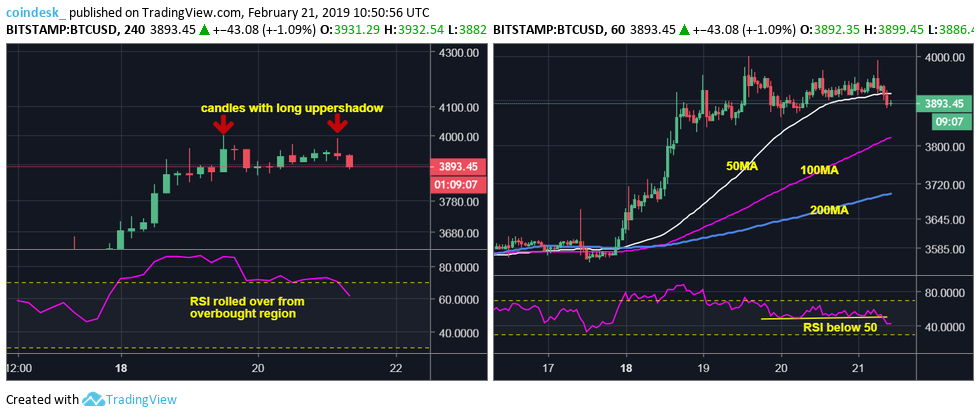View
- Bitcoin’s three-day chart is showing a bullish crossover of the 5- and 10-day exponential moving averages for the first time since July. The crossover looks decisive as both EMAs are now trending north, validating the bearish-to-bullish trend change signaled by the high-volume triangle breakout seen on the 3-day chart.
- The cryptocurrency could test December highs above $4,200 in the near term.
- A minor pullback to $3,800 may be seen in the next 24 hours, as signs of bullish exhaustion have emerged on the hourly and 4-hour charts.
- The bullish case would weaken if BTC finds acceptance below $3,614 (the low of the previous three-day candle), but that currently looks unlikely.
A much-followed bitcoin (BTC) price indicator has turned bullish for the first time in seven months, indicating a trend change in the market.
On the three-day chart, the 5-candle exponential moving average (EMA) has crossed the 10-candle EMA from below – the first decisive bullish crossover since July 17, 2018.
Back then, BTC was trading above $7,300 and the crossover was followed by a rally to highs above $8,400 on July 24.
Moving average crossovers help identify shifts in momentum. A bearish-to-bullish trend change is confirmed when a short-term moving average crosses through a long-term average from below.
Many would argue that EMA crossovers are lagging indicators. While that is true, crossovers between the short duration averages help traders distinguish between bullish and bearish scenarios. The long-term MA crossovers like the “golden cross” (bullish crossover of the 50-and 200-day MAs) often work as contrary indicators.
The latest positive crossover seen in the three-day chart validates the bullish break above $3,800 witnessed earlier this week. As a result, December highs above $4,200 could soon be put to the test.
As of writing, BTC is trading at $3,894 on Bitstamp, having clocked a high of $3,990 earlier today.
3-day chart
As seen above (left), the 5- and 10-day EMAs have produced a decisive bullish crossover, i.e. the averages are trending north following the bull cross. The chart to the right shows July’s bullish cross. After a brief rally following the cross, the averages became flat-lined in the three months up to Nov. 14, offering little directional bias.
In the current scenario, BTC’s last three-day candle closed at $3,936, confirming a triangle breakout, which also indicates a bearish-to-bullish trend change. Further, the candle closed well above $3,711, validating the bullish outside reversal created in the three days to Feb. 15.
Even so, December highs above $4,200 may not come into play immediately, as the short duration charts have turned bearish.
4-hour and hourly chart
The long upper shadows attached to multiple candles on the 4-hour chart signal bullish exhaustion near $4,000.
The relative strength index (RSI) on the 4-hour chart has also rolled over from the overbought territory and is pointing southwards. Meanwhile, the RSI on the hourly chart has turned bearish below 50.00.
As a result, BTC could revisit $3,800, before resuming the rally toward $4,236 (Dec. 24 high), as suggested by the three-day chart.
The stacking order of the 50-hour MA, above the 100-hour MA, above the 200-hour MA, also indicates that any dip to $3,800 could be short-lived.
Disclosure: The author holds no cryptocurrency assets at the time of writing.
Bitcoin image via Shutterstock; charts by Trading View





